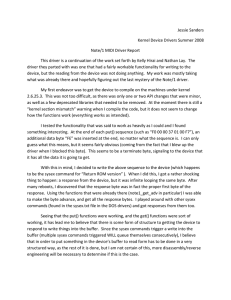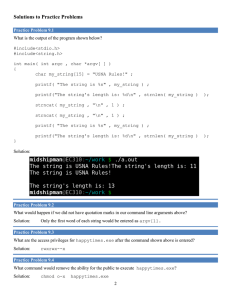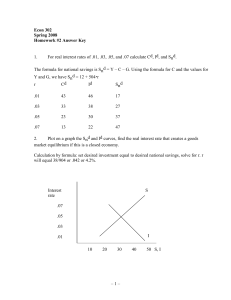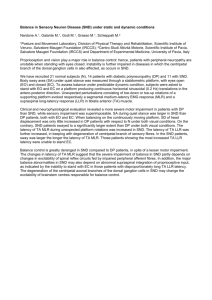The Note/1 Driver Design
advertisement
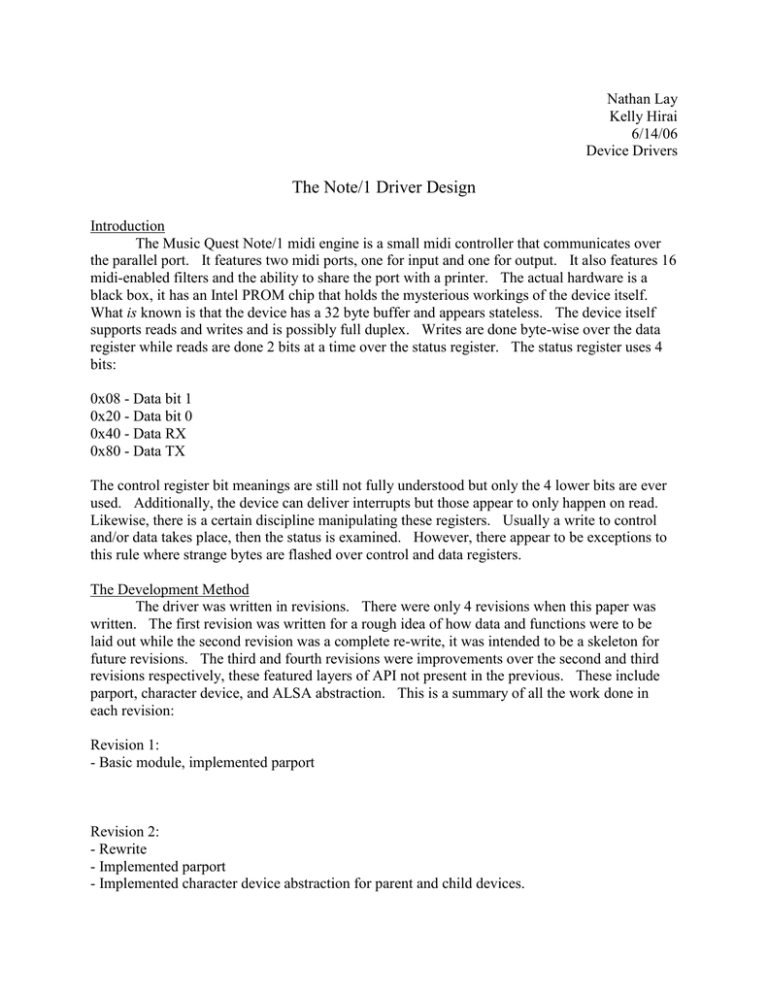
Nathan Lay
Kelly Hirai
6/14/06
Device Drivers
The Note/1 Driver Design
Introduction
The Music Quest Note/1 midi engine is a small midi controller that communicates over
the parallel port. It features two midi ports, one for input and one for output. It also features 16
midi-enabled filters and the ability to share the port with a printer. The actual hardware is a
black box, it has an Intel PROM chip that holds the mysterious workings of the device itself.
What is known is that the device has a 32 byte buffer and appears stateless. The device itself
supports reads and writes and is possibly full duplex. Writes are done byte-wise over the data
register while reads are done 2 bits at a time over the status register. The status register uses 4
bits:
0x08 - Data bit 1
0x20 - Data bit 0
0x40 - Data RX
0x80 - Data TX
The control register bit meanings are still not fully understood but only the 4 lower bits are ever
used. Additionally, the device can deliver interrupts but those appear to only happen on read.
Likewise, there is a certain discipline manipulating these registers. Usually a write to control
and/or data takes place, then the status is examined. However, there appear to be exceptions to
this rule where strange bytes are flashed over control and data registers.
The Development Method
The driver was written in revisions. There were only 4 revisions when this paper was
written. The first revision was written for a rough idea of how data and functions were to be
laid out while the second revision was a complete re-write, it was intended to be a skeleton for
future revisions. The third and fourth revisions were improvements over the second and third
revisions respectively, these featured layers of API not present in the previous. These include
parport, character device, and ALSA abstraction. This is a summary of all the work done in
each revision:
Revision 1:
- Basic module, implemented parport
Revision 2:
- Rewrite
- Implemented parport
- Implemented character device abstraction for parent and child devices.
- Added a single ioctl command for probing.
- Wrote note1ctl that commands a parent node to probe for newly attached Note/1 devices.
Revision 3:
- Added /proc entry that displays device information for each attached Note/1 device.
- Removed character device support for child nodes, this wasn't needed.
- Added ALSA support.
Revision 4:
- Changed locking methods for parport.
- Improved read/write ALSA methods.
The Design
Initially one of the major design concerns was the ability to stack on the existing parport
driver. Along with this concern was the highly unlikely event that somebody might have more
than one Note/1 device attached to the system. Luckily, the parport documentation guarantees
us that there will be no more than PARPORT_MAX parallel ports supported. For the PC,
PARPORT_MAX defaults to 16. So, in light of this information, the driver holds an array of
note1_device pointers set to the size of PARPORT_MAX. On initialization this array is
NULL'd out.
struct note1_device {
struct semaphore sem; /* For locking */
struct pardevice* par; /* Pointer to our port */
struct snd_rawmidi* rmidi; /* ALSA Raw Midi */
struct snd_card* card; /* Our Sound Card */
int busy, claimed, opened; /* parport preempt lock */
};
static struct note1_device* note1_devs[ PARPORT_MAX ];
This array is primarily used for lookup and cleanup as it is used to manage our memory. But
before we can make any use of this, the driver must be registered for parport.
struct parport_driver {
const char *name;
void (*attach) (struct parport *);
void (*detach) (struct parport *);
struct parport_driver *next;
};
int parport_register_driver (struct parport_driver *driver);
The parport_register_driver is used to make the parport driver aware of our driver as
well as provide access to the parallel port. The attach and detach functions our ways to make
our driver aware of the parallel ports available and the attach function is triggered for all
available ports as soon as the driver is registered. Likewise the detach function is called when a
parallel port is no longer available to the system or when parport_unregister_driver is
called. The attach function is a perfect place to probe for devices, in fact that's exactly what
happens.
Our real memory management happens in the attach function. First,
note1_getadd() finds an available slot in the note1_devs array. This can include any
NULL'd position, or any allocated data structure that is not already associated to a port. The
latter can happen if the parallel port vanishes for that structure or if there was no device to begin
with. It is of note that no data structure is deallocated as memory is scarce and this prevents
fragmentation. Instead, these already allocated device structures sit in note1_devs until they
can be useful or until cleanup. To summarize, suppose there are three parallel ports and the
Note/1 device is attached on the third port, then when the attach function is first called, the first
position in note1_devs is returned, but since it is NULL, it is allocated and initialized. Then
it attempts to probe the the first port and finds nothing. Then when the attach function is called
for the second time, it picks the first position in the array again, since it is not associated,
likewise this will fail. Lastly it will do the same and associate to the third port.
void note1_attach( struct parport* port ) {
struct note1_device** p = note1_getaddr();
struct snd_card* card;
int res;
if ( !p ) {
printk( KERN_ALERT "%s: Cows can finally fly!\n",
NOTE1_DEVNAME );
return;
}
if ( !*p ) {
card = snd_card_new( note1_count, NOTE1_DEVNAME,
THIS_MODULE, sizeof( struct note1_device ) );
if ( card == NULL ) {
printk( KERN_ALERT "%s: Unable to allocate card memory!\n",
NOTE1_DEVNAME );
return;
}
++note1_count;
*p = card->private_data;
/* Initialize the allocated memory */
memset( *p, 0, sizeof( struct note1_device ) );
init_MUTEX( &(*p)->sem );
(*p)->card = card;
res = snd_rawmidi_new( (*p)->card, NOTE1_DEVNAME, 0,
1, 1, &(*p)->rmidi );
if ( res < 0 ) {
printk( KERN_ALERT "%s: Unable to allocate midi memory!\n",
NOTE1_DEVNAME );
snd_card_free( (*p)->card );
*p = NULL;
return;
}
(*p)->rmidi->private_data = *p;
strcpy( (*p)->rmidi->name, NOTE1_DEVNAME );
(*p)->rmidi->info_flags = SNDRV_RAWMIDI_INFO_OUTPUT |
SNDRV_RAWMIDI_INFO_INPUT;
snd_rawmidi_set_ops( (*p)->rmidi, SNDRV_RAWMIDI_STREAM_INPUT,
&snd_note1_input_ops );
snd_rawmidi_set_ops( (*p)->rmidi, SNDRV_RAWMIDI_STREAM_OUTPUT,
&snd_note1_output_ops );
if ( snd_card_register( (*p)->card ) ) {
printk( KERN_ALERT "%s: Unable to register the card!\n",
NOTE1_DEVNAME );
snd_card_free( (*p)->card );
*p = NULL;
return;
}
}
if ( !note1_register_port( *p, port ) && note1_probe( *p ) )
note1_unregister_port( *p );
else
printk( "Found device!\n" );
}
It is of note that we rely on snd_card_new to allocate our memory for convenience reasons.
This, of course was only recent to Revision 3 since ALSA API was added in that revision, before
it used kmalloc. One caveat to this memory management technique is that the initialization
requires us to register the card, even if there might be no Note/1 devices connected. Registering
the card makes our callbacks available to ALSA (they will always fail if there is no device).
After initialization, the device attempts to register a port to itself with
note1_register_port so it can then attempt to claim the port as well as register parport
specific callbacks (such as an interrupt handler). This function only relies on
parport_register_device:
struct pardevice *parport_register_device(struct parport *port,
const char *name,
preempt_func preempt,
wakeup_func wakeup,
irq_func irq,
int flags,
void *handle);
Where preempt is the parallel preemption function, wakeup is a function that reacts on an
available port and irq is the interrupt handler. The preempt function will surrender the port to
another driver if it is not in use, likewise, the wakeup function will be triggered if a port becomes
available. The Note/1 driver only uses preempt and irq since it is able to share the port with a
printer and delivers interrupts. If this succeeds, attach is able to call the probing function which
determines if the port is to remain associated to the device or not.
Put aside until now, the attach function also sets up the appropriate ALSA callbacks on
initialization. Since our device is independent of any recognized sound chip, we must use the
Raw MIDI API that ALSA provides. The callback functions associated with Raw MIDI
include:
Input/Output open - Opens a stream
Input/Output close - Closes a stream
Input/Output trigger - Triggers input and output for a stream
and Output drain - Dumps the remaining output buffer to the device.
Since our device is byte stream oriented, it does not need a drain function. This is because
trigger is guaranteed to take care of that detail for us.
To initialize the driver for use with ALSA, one must initialize a snd_card. A
snd_card is a structure that describes a list of sound interfaces through components. One of
those components include the Raw MIDI interface. Then one must register a snd_rawmidi
structure into the card and associate the snd_rawmidi_ops input and output callbacks into
the snd_rawmidi structure. Finally, snd_card_register makes the card available to
the system for use, its important that this is done after initializing the snd_card.
There are two types of locking needed for this driver. There is the usual kernel lock (e.g.
semaphore, mutex, spinlock ... ), and to protect the claimed parallel port there is a busy counter.
Since there is no real locking issue with concurrency, the big problem lay with port preemption.
Initially, the note1_device structure had a mode mask that described the various states of the
devices. These states included: opened, busy, and claimed. To protect the previous mode,
functions that wanted to change the mode needed to store the current mode. Unfortunately, the
problem with this approach became apparent with concurrency. Suppose the device is idle and
its opened for input. It stores the current idle mode and sets the mode to busy. Now suppose,
at the same time, the device is opened for output, it stores the current busy mode and sets the
mode to busy again (which has no effect). Now, when the input method is finished it resets the
previous mode it stored, which happens to be the idle mode, despite the fact that the output
method intended to be busy too. So, to remedy this issue a busy counter is instead used.
Whenever a function intends to be busy, it just increments the busy counter, and when its
finished, decrements the counter, promising that the driver's mode is not compromised. To
reiterate, this busy counter protects the port from preemption.
#define note1_isbusy( dev )
#define note1_setbusy( dev )
#define note1_unsetbusy( dev )
( (dev)->busy )
( ++(dev)->busy )
( --(dev)->busy )
int note1_preempt( void* handle ) {
struct note1_device* dev = (struct note1_device*)handle;
if ( note1_isbusy( dev ) )
return -1;
note1_unsetclaim( dev );
return 0;
}
When the cleanup routine is run, the module unregisters the associated snd_card
structures (from the note1_devs array) with snd_card_free. It is of note to mention that
this method removes the ALSA callbacks as well as free the memory for our note1_device
structure.
void __exit note1_exit( void ) {
struct note1_device** p;
#ifdef NOTE1_DEBUG
printk( KERN_NOTICE "note1_exit() called!\n" );
#endif
parport_unregister_driver( &note1_ppd );
for ( p = note1_devs; p < note1_devs+PARPORT_MAX; ++p )
if ( *p ) {
snd_card_free( (*p)->card );
}
cdev_del( &note1_cdev );
unregister_chrdev_region( note1_major, NOTE1_DEVS );
remove_proc_entry( NOTE1_DEVNAME, NULL );
}
![Exchange Control Notice [ECM3] for External Account](http://s3.studylib.net/store/data/008233047_1-c0ddc05986c09989df7cd8a6404559d9-300x300.png)
